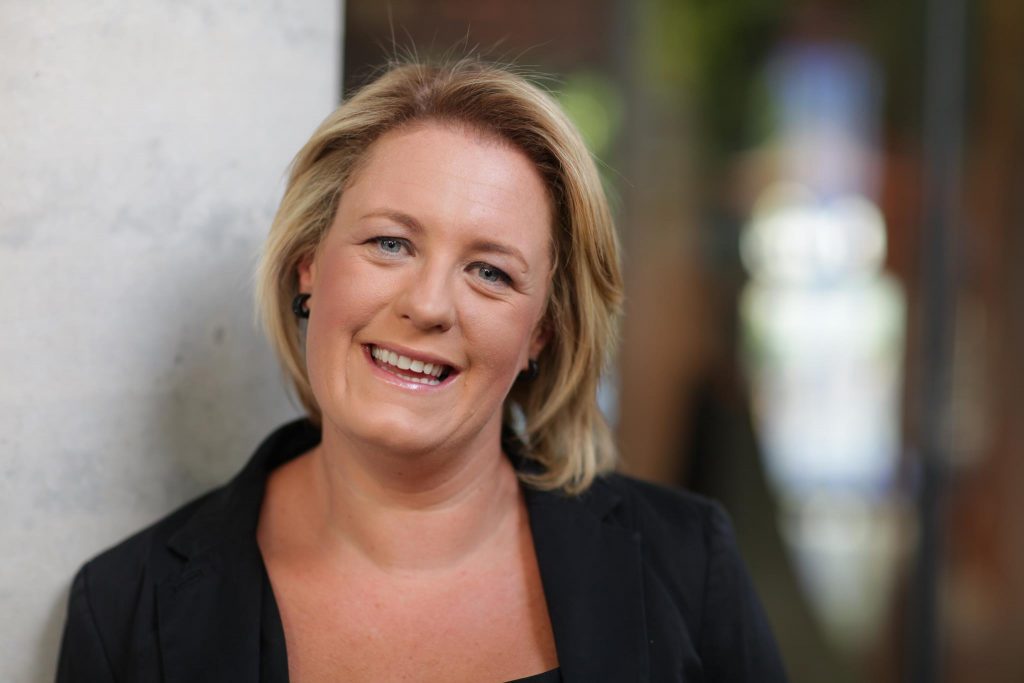Canberra Communications Professional Series: Kate Bradstreet
Kate is a media and issues management specialist who runs her own consultancy, Kate Bradstreet Communications. Kate works between Canberra and Melbourne, always swearing she is trying to reduce her hours and slow down, but can’t help but be seduced by the next big challenge. An avid believer in the power of storytelling, Kate manages tricky issues through authenticity, empathy and building strong relationships.
What did you do before starting your own consultancy?
I started my career in regional newspapers at The Bay Post newspaper in Batemans Bay. The minute I walked onto the newsroom floor, I absolutely loved it. And my passion for storytelling has only grown since that very day. I could see – through being a journalist – the impact that finding a connection through a personal story could have on a larger social issue. What I found out very early in my career is that through sharing one’s person’s experience there was the ability to drive change – that change could be support for another person going through a similar experience or influence large scale social policy. I always look to try and find the connection point. The first questions I ask on any new subject are: “Why should people care about this?” What impact does it have on their life?”. I was appointed editor of the Bay Post at 23-years-old. Looking back, I was completely out-of-my-depth, but it was one of those sink or swim moments and I am forever grateful for the experience and how it has shaped my career. The connection with the community was so strong and to this day, it was still my favourite job.
Working in metro newspapers in Sydney helped build my understanding of influence and impact. How a media campaign could have both positive, but sometimes negative outcomes. The power of the pen was something I never took lightly as I understood what it could do.
Following journalism, I started my public relations career at the Australian Federal Police. Similar to the thrill of journalism, this organisation was going through major growth domestically and internationally. My role was to help shape the narrative and position the organisation. There were highly sensitive investigations and contentious policy debate around counter-terrorism that gained large-scale attention. My foray into crisis communications began at the AFP with the Bali bombings, the Garuda plane crash in Indonesia – which sadly killed many Australians – and international crime syndicate investigations, such as the arrest of drug kingpin Tony Mokbel.
Following the AFP, I was involved in helping shape the story of climate change – at the time when the then-Labor Government was pushing carbon price legislation through Parliament. Finding a human connection of what changing climate conditions would mean for future generations was a big part of the role. Trying to simplify and amplify the “why” people should care about the impact of climate was very important work.
I strongly believe that all necessary change starts with “what” matters. A storyteller’s ability to find an emotional connection to show “why” it matters is what drives that change.
What does a normal day look like for you?
I am up pretty early and pounding the pavements with my two furry mates – Summer and Poppy. My day starts with listening to stories. I’m either playing an audible book, or tuning in to the latest news. I am a bit of a news junkie and like to see though out the day how different media outlets cover the big stories and the angles they take. Because a lot of my work involves mostly controversial and contentious subject matters with a strong political overlay, I use my walking time to strategise about how I will handle things.
Currently, my work is between Melbourne and Canberra, so there is a lot of planning and travel logistics that also come into play. Earlier in the year, I had the privilege of working on the bushfire response in Victoria. In the immediate aftermath of the fires, I got to travel to 32 communities across the State to hear the devastating first-hand impacts the fires had on many small communities. My job was to support the engagement with these communities and link policy and funding support to direct need. In my world, no day is really “standard” and I love it.
It keeps me energised juggling many balls and I am lucky that being in the business allows me to have a hand in different projects and subject matters. There is never a dull moment.
Can you tell us about one of your career highlights?
This is a hard question! I have had many, many moving experiences in my career. The last five years have been a stand-out from a large-scale impact perspective, working on major reforms and I have learnt a lot during this time.
At a personal level, I felt a deep connection to the work that I did to support the national agenda on violence against women and children. Supporting Ken Lay AO APM and Rosie Batty (Australian of the Year) to drive a national conversation about male attitudes towards women was incredibly meaningful and rewarding work.
The message to help people – “think, feel and act” about their deeply embedded gendered attitudes led to the issue being a taboo and “behind closed doors” to a national conversation focused on what societal changes were needed to keep women safe. The impact of the women’s stories were so powerful in this reform.
What is the biggest challenge you have faced in your career? How did you overcome it?
Standing in the Dondale Youth Detention Centre in Darwin on a 45-degree day where there were girls as young as 7 incarcerated. I was responsible for communications and media for the Royal Commission that had been called into treatment of young people – mostly Aboriginal youth – while in detention.
It struck me so starkly on that day, when I was listening to their stories of mistreatment and abuse, that children of that age don’t choose to be criminals, but their life circumstances had led them to be in this situation. I felt so strongly about the need to have their stories heard – and heard loudly by those in positions of power that could make a difference in their lives.
The struggle on the project was immense. The context and the environment made the job very challenging. There was no social push for change to occur in the Northern Territory, I faced a hostile Government and media and had to fight very hard to have the children’s stories heard.
It was a delicate balancing act between protecting the children but knowing the power in their shared experience would be the key factor to driving significant cultural change.
I had a great team around me at the time who really supported the Commission’s work and were passionate to do what it took to engage, encourage more people to come forward to share their experience and push the message far and wide. The dedication of effort was monumental, and I learnt a very good lesson about understanding the impact you can have on a personal level, but also being realistic about long-term attitudinal and cultural change.
What changes do you think will occur in communications over the next decade?
Authenticity! No longer can organisations and leaders get away with rolling out the standard “corporate lines and messages.” When mistakes are made, leaders need to own it, front foot it and share their plan to address issues.
In communicating with people, we have to fundamentally bring the person who is communicating to the fore. They need to form an immediate and real connection with their audience for any message to resonate. I think as communication professionals, it is our role to encourage, to test, to challenge the status quo when the first reaction is to hide information, or let it stay behind closed doors.
We as leaders should be engaging when we have a good story to tell, but also when the news isn’t great. We are already starting to see the shift to leaders showing up as their true selves and allowing their vulnerabilities to help with their connections – internally and externally. When you communicate from the inside out, it drives behaviour. As audiences are more aware, more engaged, more online – leaders and organisations who show up as their true selves and engage in a meaningful way will have the best chance to influence the agenda.
What is your favourite book or podcast?
I cannot go past ABC Conversations with Richard Fidler. I can get transported deep into the world of interesting people and their lives. The most interesting people on the podcast are those ordinary people who have had extraordinary experiences. For the hour-episodes I feel like I am walking in their shoes.
Who has been the most influential person in your career? Why?
I am inspired by leaders who have done the work to have a deep understanding of themselves, have reflected on how important events and interactions with others have shaped their approach to the world and can then connect that through their work.
For the last five years I have had the privilege of working on many different social policy projects with Ken Lay AO APM. He is a leader who listens, has empathy, front foots the issues and has a deep understanding of community. He has worked for his whole policing career and as Chair on many Boards to drive reform, including on drug related issues, health reform and organisational change. I am inspired every day by his ability to connect and understand the required reforms at a Government, organisational and personal level.
If you could share one tip with other communications professionals what would it be?
Those who share the stories change the world (Native American proverb (amended).
Never forget the important role you have in being that connection point. Always bring your message back to what is going to matter to people the most.

A bit more about Kate…
Through bringing personal stories to life, Kate Bradstreet has focused her career on connecting with audiences through stories of adversity, strength and success.
Through her business, Kate Bradstreet Communications, she has advised on many high-profile national social issues including leading the communication and engagement for many Australian and Victorian Government taskforces. This includes the Northern Territory Royal Commission into the Detention and Protection of Children, the Prime Minister’s National Ice Taskforce and with Ken Lay AO APM and Rosie Batty on the Council of Australian Governments’ Advisory Panel on Reducing Violence against Women and their Children. Kate has held senior media and communication advisory positions to Australian police commissioners, CEOs and Boards.
In 2020, Kate was the Chief of Staff to Ken Lay AO APM at Bushfire Recovery Victoria where she visited and engaged with 32 communities impacted by the devastating 2020 bushfires to direct the Government’s response to the crisis.
A former newspaper journalist and editor, Kate has built strategic relationships with media nationally and internationally and communicated serious government reforms such as climate change, water reform and disability.
Kate holds a Master of Strategic Communication and a Bachelor of Arts in Media and Communication Studies.
Last year Kate received international accolades, through being awarded three Gold Quill awards for her transformational work at Ambulance Victoria from the International Association of Business Communicators. She is the recipient of a scholarship through Chief Executive Women for Melbourne Business School and was selected to be part of the Victorian Government’s Women’s Board Leadership Program.

